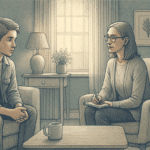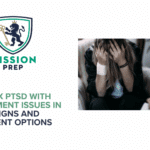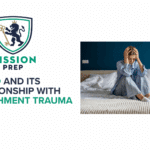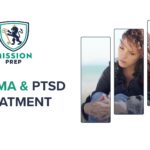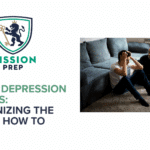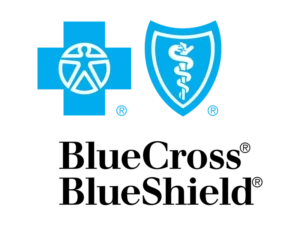PTSD Interventions for Teens: Ways to Help Teens Recover from Trauma

Traumatic events can impact teenagers in a range of ways, potentially harming their physical, emotional, social, or spiritual health. Witnessing a teen struggle and possibly suffer from post-traumatic stress disorder (PTSD) can be highly difficult, especially if you’re not sure how you can help.
Nightmares, worsened moods, hypervigilance, and flashbacks in teens can feel like a minefield for loved ones. Yet, when you can recognize a teen’s trauma response, you’ll find it easier to support them. Therefore, the first step is understanding how PTSD works, the symptoms it can cause, and its triggers.
Following this step, post-trauma care in adolescence might require a combination of therapy, medication, grounding exercises, emotional processing, and self-care strategies. This is where a mental health professional can step in.
This article can also help, giving you all the information you need on PTSD in teens, including:
- What PTSD is and its causes
- Symptoms of PTSD in teenagers
- What caregivers can do at home to support a teen with PTSD
- The different types of PTSD support for teens
- How to help a teen in a PTSD panic attack

What Is PTSD?
A traumatic event is defined as exposure to an overwhelming or distressing event, whether these events are actual or threatened. The definition isn’t limited to directly experiencing something yourself; it includes witnessing another person experience trauma or knowing something traumatic happened to a close friend or family member.1
Trauma can also be defined as something that has lasting impacts on someone’s physical, emotional, social, or spiritual well-being.2
Potential causes of PTSD in teenagers include sexual assault, physical injury, car crashes, political conflict, medical illness, death of a veteran family member, bullying, abuse or neglect, and natural disasters.1 If the trauma is accidental or non-violent, there’s a lower risk of developing PTSD. However, if the trauma is intentional and/or violent, the risk of PTSD is higher.
Some theories suggest that trauma changes people’s beliefs about the world being a safe place. If someone has intentionally harmed them, this belief could be shattered in a more significant way, as they may start to believe that others can’t be trusted.1
When a traumatic event happens, there’s a surge of adrenaline and cortisol, and increased blood pressure. Plus, if the traumatic event is prolonged or repeated, the brain can develop a conditioned response. As a result, someone with PTSD may be less able to regulate their stress response, and experience it activating almost constantly – especially when reminded of the event.1
Further, if someone experiences traumatic events repetitively over a long period of time, they could develop complex post-traumatic stress disorder (C-PTSD). C-PTSD shares symptoms of PTSD, but has additional ones which we’ll explore next.3
What Does PTSD Look Like in a Teenager?
Experienced a traumatic event- Suffer from intrusive memories and nightmares
- Carry out behaviors to avoid memories or thoughts around the event (such as avoidance)
- Have a worsened mood, negative thoughts, and beliefs
- Are more alert or hypervigilant
People with PTSD might also have dissociative symptoms, which are different from having a dissociative disorder. Dissociative symptoms can be split into two categories: depersonalization and derealization. These involve:
- Depersonalization: Feeling detached from your identity or character, as though you’re observing yourself from outside of your body. Depersonalization also includes a sense that your thoughts, memories, or body movements don’t belong to you. For instance, you might feel disconnected from your physical appearance as though you don’t recognize yourself, or sense that your limbs are twisted or out of shape.
- Derealization: Feeling disconnected from your environment, like the world is a dream or film, or having a sense of time being distorted or unreal. It might seem like there’s a veil between you and the world, a distance between you and people you care about, and that your environment is two-dimensional or colorless.
Complex PTSD in teenagers includes the symptoms listed above, as well as some that are categorized as disturbances of self-organization. This means that someone’s sense of self has been impacted. They may have feelings of worthlessness, struggle to maintain relationships with and feel close to others, and have heightened emotional responses.3
What Parents Should Know About Their Teen With PTSD
So, how can you best support your teen living with PTSD? Firstly, understanding what they’re going through can help significantly. Familiarizing yourself with the causes and symptoms of PTSD may help you better understand their behavior and inform your approach. The less information you have, the more likely you’ll feel confused and powerless to help.
Another way you can help your teen is to ensure they know they can communicate openly with you. You might think that avoiding difficult conversations protects your child from negative feelings, but talking is often a necessary part of healing. For instance, you might share your own experiences and feelings with them, or simply remind them you’re there to talk if they want.
However, your teen might struggle to talk about what’s happened without triggering their PTSD. In this case, you should ask them how deeply or superficially they want to discuss the event, instead of asking about the specific details.1
As may be clear, living with PTSD can be a daily challenge. Your teenager might struggle with sleep, become angry or rebellious, or seem not to want your support. But there are still ways you can help. Effective parental support for teens with PTSD could include:
Increasing your teenager’s sense of safety through routine and stability- Maintaining household rules without shaming their rule-breaking
- Notifying their school about what they’re going through
- Seeking out trauma-informed professional help on their behalf
- Reinforcing therapeutic techniques at home, like grounding techniques and calming down from panic attacks
PTSD Help For Teens: Types of Support
Trauma support groups for teens: These are a great opportunity for teens to speak with peers about their shared experiences. As well as providing a sense of validation and community, group dynamics can foster confidence and teach teens new coping mechanisms that have worked for others.
- EMDR therapy for teens: EMDR is an evidence-based therapy that uses eye movement to reprocess painful memories and thoughts. It can help people with PTSD change their thoughts and feelings about traumatic experiences and reduce their stress response.
- Trauma-informed therapy: This can provide a safe space for teens to process what’s happened without being retraumatized. They’ll be taught emotional regulation, self-care skills, coping strategies, and how to foster a sense of self-confidence.2
Alongside counseling and psychotherapy, medication may or may not be useful. There’s no medication specifically approved for treating PTSD, but your teen may benefit from medicines for sleep or anxiety if these are areas they struggle with.
There are also some teen trauma recovery strategies they can do by themselves. In fact, coping skills designed to boost self-confidence and sense of control could be especially beneficial. These include:
- Identifying their PTSD triggers
- Learning grounding techniques for staying in the present
- Developing a mantra that reminds them they’re safe
- Practicing mindful breathing
- Carrying an object that acts as a grounding tool
- Practicing self-compassion about their recovery journey
What to Do in a PTSD Panic Attack
It’s important that teens and their loved ones know how to calm down from a flashback or panic attack. These events may lead to heart palpitations, rapid breathing, and lightheadedness, causing them to worry they’re dying or losing control. Some things that may help include:
- Reminding them that their physical panic symptoms are not dangerous and they’re not having a heart attack. For example, tell them that the same sensations could arise during exercise, but don’t feel as worrying
- Slowing down their breathing and trying to lengthen their “out” breath. This can activate their nervous system back into “rest and digest” mode
- Prompting them to look at their surroundings and label what they see. This can help pull them back into the present moment
- Physical sensations like tasting lemon or running hands under cold water can also be grounding as they require focusing on their senses
Knowing what to do in a situation like this can give you confidence in your ability to support your teen. However, it needn’t be your sole responsibility. There are numerous ways your teen can be supported to take the pressure off of you both.

Mission Prep: Support For Teen PTSD Today
If your teen is suffering from PTSD, you might feel powerless and overwhelmed with concern. However, there is a range of PTSD treatment options for young people, and a lot is known about the condition.
At Mission Prep, we offer a variety of therapies for young people, including treating trauma and utilizing EMDR. We understand how mental health challenges can impact teenagers’ academic performance and family life, and these are incorporated into their care. We’ll work with them and you to create a personalized treatment that helps them feel listened to and supported in the ways that they need.
If you’d like more advice or simply have questions you’d like answered, contact our team today.
References
- Mann, S. K., Marwaha, R., & Torrico, T. J. (2024). Posttraumatic stress disorder (PTSD). PubMed; StatPearls Publishing. https://www.ncbi.nlm.nih.gov/books/NBK559129/
- National Library of Medicine. (2020). Trauma-Informed Care: A Sociocultural Perspective. Nih.gov; Substance Abuse and Mental Health Services Administration (US). https://www.ncbi.nlm.nih.gov/books/NBK207195/
- University of Zurich. (2022, July 1). Complex post‑traumatic stress disorder [Press release]. ScienceDaily. Retrieved July 28, 2025, from https://www.sciencedaily.com/releases/2022/07/220701113149.htm
- Murphy, R. J. (2023). Depersonalization/Derealization disorder and neural correlates of trauma-related pathology: A critical review. Innovations in Clinical Neuroscience, 20(1-3), 53–59. https://pmc.ncbi.nlm.nih.gov/articles/PMC10132272/

